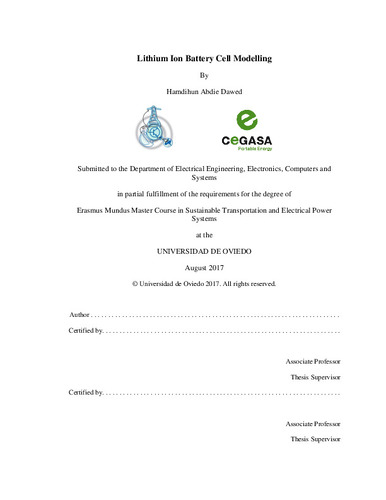Lithium Ion Battery Cell Modelling
Autor(es) y otros:
Director(es):
Fecha de publicación:
Serie:
Máster Universitario Erasmus Mundus en Transporte Sostenible y Sistemas Eléctricos de Potencia (EMMC STEPS)
Descripción física:
Resumen:
In this thesis, a lithium ion battery cell is analyzed and modelled on MATLAB. Under lithium ion battery there are different chemistries. The electrical and thermal performance of each chemistry varies depending on the operating conditions. Developing a model of performance which accounts the current rating, operating temperature and state of charge (SoC) helps to analyze the behavior of the cell under load. Different approaches of modelling lithium ion battery cells are proposed in literature, physics based electrochemical model and empirical (such as equivalent circuit-EEC model) are the most discussed. In this work, empirical based EEC model is designed and simulated for various working conditions. The model has a variable voltage source which accounts the open circuit voltage (OCV) as a function of state of charge and temperature, a series resistor to account the instantaneous voltage change when the cell is under load or relaxed, and parallel resister-capacitor (RC) branches to capture the dynamics of the cell during transient. The battery cell is exercised under different current rate, state of charge and temperature; and data is recorded for impedance parameters identification. Curve fitting techniques are applied to determine the number of RC branches. Two/Three RC branches are chosen based on a trade-off between fitting goodness of the transient characteristics of the selected battery cell and the parameter identification complexity. Trust-Region-Reflective method based on least square algorithm on Simulink optimization toolbox is used to identify the parameters (resistor and capacitor as a function of temperature, current rate and SoC). The cost function in the optimization problem is sum squared error of the terminal voltage. The estimated parameter values are highly nonlinear and represented in the model by 3D lookup tables with linear interpolation. Coulomb counting method is applied to estimate SoC which considers temperature dependent maximum capacity of the cell. OCV is modelled in terms of 2D lookup table with smooth interpolation, as a function of SoC and temperature, from measurement data using pulse charge-discharge technique with 1-hour relaxation time. Once the impedance parameters are estimated, OCV model is improved by estimating new data points to handle the limitation of coulomb counting SoC estimation due to current measurement
In this thesis, a lithium ion battery cell is analyzed and modelled on MATLAB. Under lithium ion battery there are different chemistries. The electrical and thermal performance of each chemistry varies depending on the operating conditions. Developing a model of performance which accounts the current rating, operating temperature and state of charge (SoC) helps to analyze the behavior of the cell under load. Different approaches of modelling lithium ion battery cells are proposed in literature, physics based electrochemical model and empirical (such as equivalent circuit-EEC model) are the most discussed. In this work, empirical based EEC model is designed and simulated for various working conditions. The model has a variable voltage source which accounts the open circuit voltage (OCV) as a function of state of charge and temperature, a series resistor to account the instantaneous voltage change when the cell is under load or relaxed, and parallel resister-capacitor (RC) branches to capture the dynamics of the cell during transient. The battery cell is exercised under different current rate, state of charge and temperature; and data is recorded for impedance parameters identification. Curve fitting techniques are applied to determine the number of RC branches. Two/Three RC branches are chosen based on a trade-off between fitting goodness of the transient characteristics of the selected battery cell and the parameter identification complexity. Trust-Region-Reflective method based on least square algorithm on Simulink optimization toolbox is used to identify the parameters (resistor and capacitor as a function of temperature, current rate and SoC). The cost function in the optimization problem is sum squared error of the terminal voltage. The estimated parameter values are highly nonlinear and represented in the model by 3D lookup tables with linear interpolation. Coulomb counting method is applied to estimate SoC which considers temperature dependent maximum capacity of the cell. OCV is modelled in terms of 2D lookup table with smooth interpolation, as a function of SoC and temperature, from measurement data using pulse charge-discharge technique with 1-hour relaxation time. Once the impedance parameters are estimated, OCV model is improved by estimating new data points to handle the limitation of coulomb counting SoC estimation due to current measurement
Colecciones
- Trabajos Fin de Máster [5292]
Ficheros en el ítem





